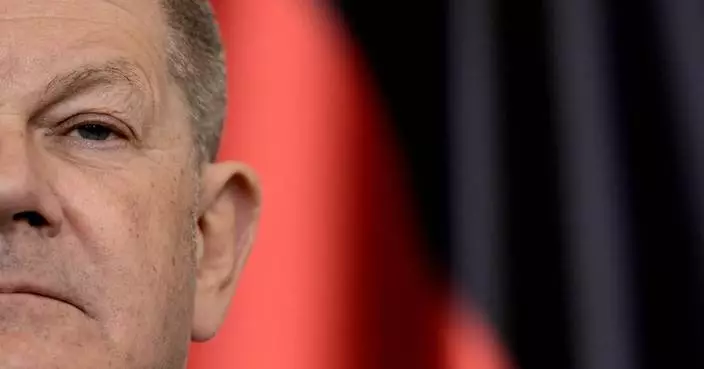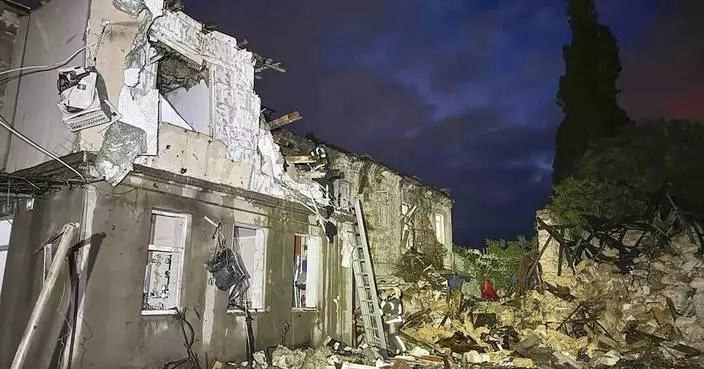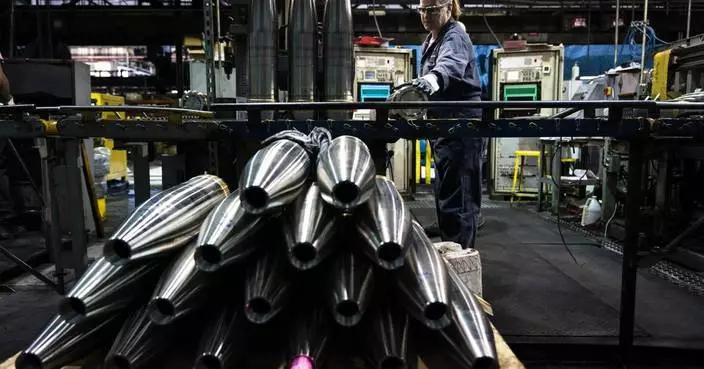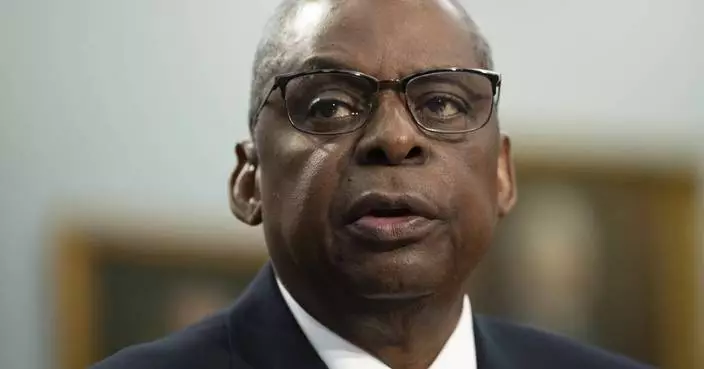South Korean President Moon Jae-in took office four months ago with plans to reach out to North Korea in a way his conservative predecessors did not in the previous decade. Two ICBM launches and one nuclear test later, his government is ramping up its defenses, with some officials even considering asking the United States to bring back tactical nuclear weapons a generation after their removal from the Korean Peninsula.
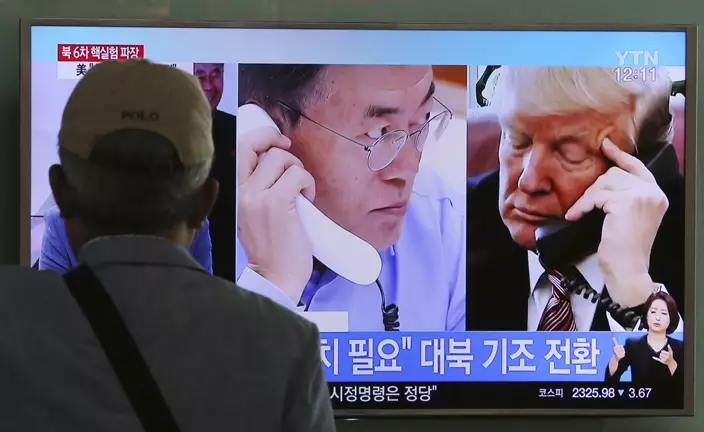
A man watches a television screen showing U.S. President Donald Trump, right, and South Korean President Moon Jae-in during a news program at the Seoul Railway Station in Seoul, South Korea, Tuesday, Sept. 5, 2017. The signs read "Need sanctions on North Korea."(AP Photo/Ahn Young-joon)
Seoul's new interest in stronger weapons received a boost Tuesday when the Trump administration agreed to remove previous restrictions on South Korean missiles.
Click to Gallery
South Korean President Moon Jae-in took office four months ago with plans to reach out to North Korea in a way his conservative predecessors did not in the previous decade. Two ICBM launches and one nuclear test later, his government is ramping up its defenses, with some officials even considering asking the United States to bring back tactical nuclear weapons a generation after their removal from the Korean Peninsula.
Seoul's new interest in stronger weapons received a boost Tuesday when the Trump administration agreed to remove previous restrictions on South Korean missiles.
This shift right by the liberal Moon underscores deep unease that the North's expanding nuclear weapons arsenal will undermine the country's decades-long alliance with the United States. Pyongyang may soon perfect an intercontinental ballistic missile that can target the U.S. mainland.
In August, South Korea conducted the last scheduled flight test of a new missile with a range of 800 kilometers (500 miles). It will soon join the "Hyunmoo" family of ballistic missiles that currently have a maximum range of 500 kilometers (310 miles).
Following North Korea's second test of an ICBM in July, Moon ordered his military to schedule talks with the United States to increase warhead weight limits on South Korea's maximum-range missiles. Moon's office didn't announce any changes to the range limit on Tuesday.
In August last year, the North successfully test-fired for the first time a submarine-launched ballistic missile that flew about 500 kilometers (310 miles). Such technology in the hands of North Korea is an alarming thought for South Korea and Japan because such weapons are harder to detect before launch.
South Koreans who support the return of U.S. tactical nukes often raise fears of rifts in the decades-old security alliance between Washington and Seoul because of North Korea's expanding nuclear weapons program.
But South Korean hunger for military strength goes beyond just missiles. Government officials also endorse the nation getting nuclear-powered submarines. And Seoul's defense minister says the idea of bringing back U.S. tactical nukes to South Korea should be "deeply considered" by the allies.
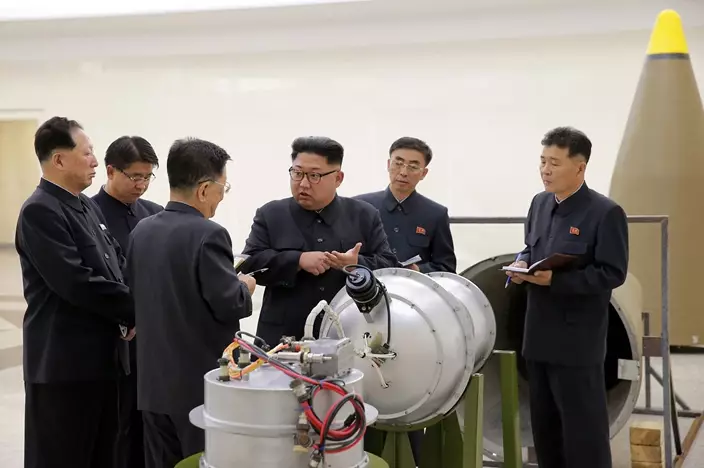
In this undated file image distributed on Sunday, Sept. 3, 2017, by the North Korean government, shows North Korean leader Kim Jong Un at an undisclosed location. (Korean Central News Agency/Korea News Service via AP, File)
This shift right by the liberal Moon underscores deep unease that the North's expanding nuclear weapons arsenal will undermine the country's decades-long alliance with the United States. Pyongyang may soon perfect an intercontinental ballistic missile that can target the U.S. mainland.
Here are some of the military capabilities South Korea is pursuing or may soon:
BALLISTIC MISSILES
South Korea says stronger missiles are crucial to the so-called "kill chain" pre-emptive strike capability it wants to use to target North Korea. A pre-emptive strike against Pyongyang's leadership would be difficult to undertake, but it's widely seen as the most realistic of the limited military options Seoul has to deny a nuclear attack from its rival.
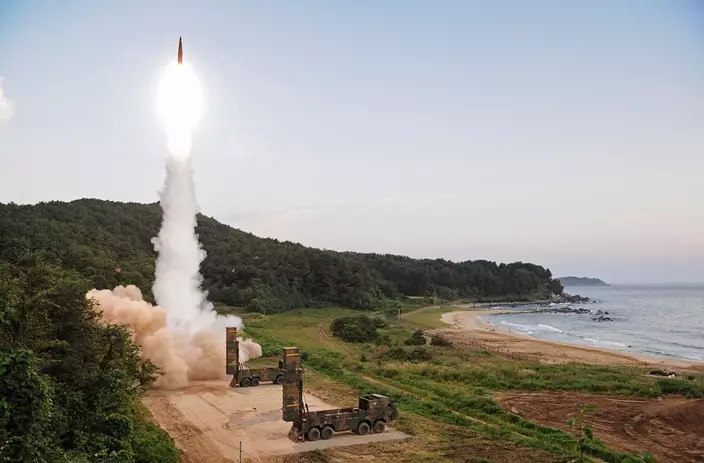
FILE - In this Monday, Sept. 4, 2017 file photo provided by South Korea Defense Ministry, South Korea's Hyunmoo II ballistic missile is fired during an exercise at an undisclosed location in South Korea. (South Korea Defense Ministry via AP, File)
In August, South Korea conducted the last scheduled flight test of a new missile with a range of 800 kilometers (500 miles). It will soon join the "Hyunmoo" family of ballistic missiles that currently have a maximum range of 500 kilometers (310 miles).
While Seoul's military says its missiles are currently capable of wiping out North Korean structures on land, it says heavier warheads are needed to target North Korea's underground facilities and bunkers.
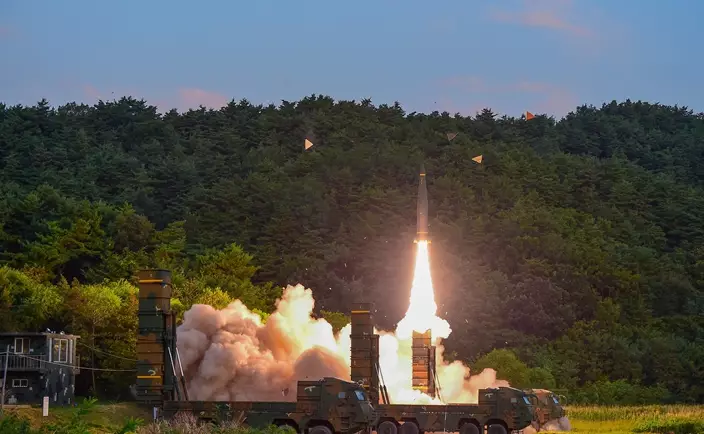
FILE, In this Monday, Sept. 4, 2017 file photo provided by South Korea Defense Ministry, South Korea's Hyunmoo II ballistic missile is fired during an exercise at an undisclosed location in South Korea. (South Korea Defense Ministry via AP, File)
Following North Korea's second test of an ICBM in July, Moon ordered his military to schedule talks with the United States to increase warhead weight limits on South Korea's maximum-range missiles. Moon's office didn't announce any changes to the range limit on Tuesday.
South Korean missile developments have been constrained by a bilateral guideline between the allies since the late 1970s, when Washington sought to check Seoul's missile development under military dictator Park Chung-hee, a staunch anti-communist who ruled South Korea in the 1960s and '70s. The restrictions have been eased over the years.
NUCLEAR-POWERED SUBS
Several South Korean government officials, including Prime Minster Lee Nak-yon, the country's No. 2, have been calling for South Korea to acquire a nuclear-powered submarine. South Korea's navy is planning a feasibility study over getting such vessels, although some experts see the possibility as low.
Supporters say such vessels are critical for coping with North Korea's submarine-launched ballistic missile system because they can operate much longer than conventional diesel-powered submarines without refueling. That gives them a better chance to find and track North Korean subs, they argue.
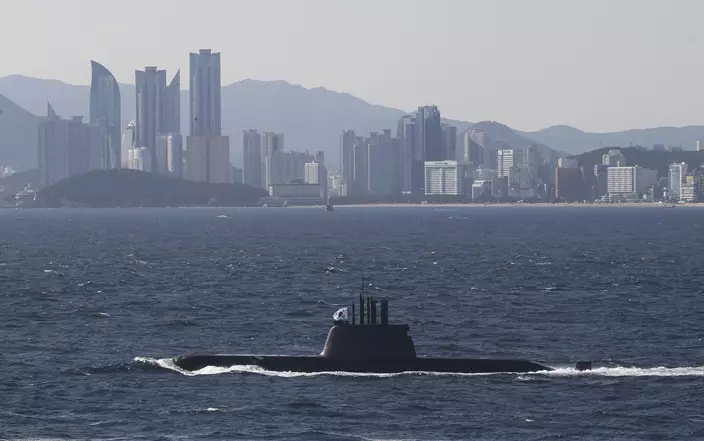
In this Oct. 17, 2015 file photo, the South Korean Navy's 1,800 ton submarine Ahn Jung Geun surfaces during a media day for a naval fleet review off South Korea's southeastern coast near Busan, South Korea. (AP Photo/Ahn Young-joon, File)
In August last year, the North successfully test-fired for the first time a submarine-launched ballistic missile that flew about 500 kilometers (310 miles). Such technology in the hands of North Korea is an alarming thought for South Korea and Japan because such weapons are harder to detect before launch.
If South Korea makes a real push for nuclear-powered subs, critics say it may never overcome political and technical hurdles. Washington may also balk at Seoul's acquisition of the enriched uranium needed to operate such submarines. Critics also argue that Washington already provides its ally a nuclear umbrella of protection and can easily ship in assets to detect and contain North Korean submarines when needed.
TACTICAL NUKES
Experts say South Korea would have an even harder time persuading the United States to re-introduce tactical nukes to the Korean Peninsula. These were withdrawn in the 1990s.
Even so, that hasn't stopped lawmakers from South Korea's largest conservative party from demanding the return of the weapons. Song Young-moo, Seoul's defense minister, told lawmakers Monday that the allies should consider the issue.
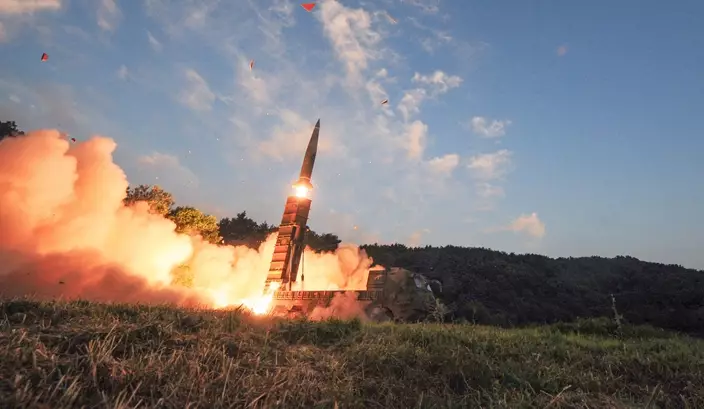
FILE, In this photo on Monday, Sept. 4, 2017, file photo provided by South Korea Defense Ministry, South Korea's Hyunmoo II ballistic missile is fired during an exercise at an undisclosed location in South Korea. (South Korea Defense Ministry via AP, File)
South Koreans who support the return of U.S. tactical nukes often raise fears of rifts in the decades-old security alliance between Washington and Seoul because of North Korea's expanding nuclear weapons program.
If North Korea obtains a fully functional ICBM, the United States might hesitate using its nuclear weapons to defend South Korea because of worries that North Korea might then strike a U.S. city, they say. Placing U.S. tactical nuclear weapons in South Korea would make clear the intent to use nukes in a crisis.
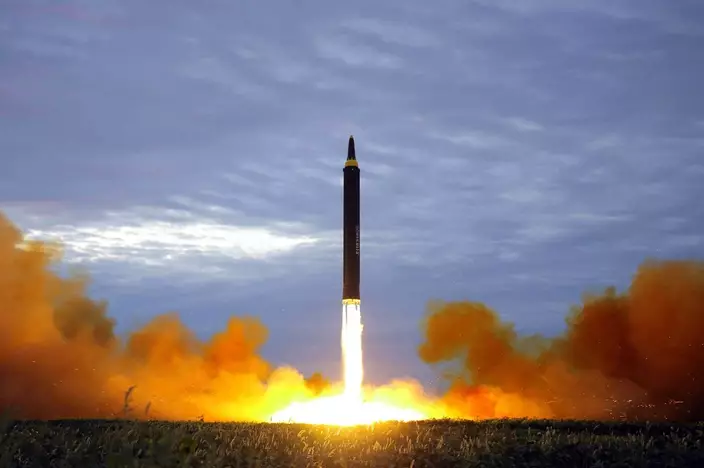
This Aug. 29, 2017, file photo distributed on Aug. 30, 2017, by the North Korean government shows what was said to be the test launch of a Hwasong-12 intermediate range missile in Pyongyang, North Korea. (Korean Central News Agency/Korea News Service via AP, File)
Critics say it's highly unlikely the United States would ever agree because it now relies on homeland and sea-based military assets to provide its allies extended nuclear deterrence. Some South Korean military experts say the nukes wouldn't meaningfully improve the South's defense and would only provide North Korea more targets to destroy or even attempt to steal.
KYIV, Ukraine (AP) — A big, new package of U.S. military aid will help Ukraine avoid defeat in its war with Russia. Winning will still be a long slog.
The arms and ammunition in the $61 billion military aid package should enable Ukraine to slow the Russian army's bloody advances and block its strikes on troops and civilians. And it will buy Ukraine time — for long-term planning about how to take back the fifth of the country now under Russian control.
“Ultimately it offers Ukraine the prospect of staying in the war this year,” said Michael Clarke, visiting professor in war studies at King’s College London. “Sometimes in warfare you’ve just got to stay in it. You’ve just got to avoid being rolled over.”
The U.S. House of Representatives approved the package on Saturday after months of delays by some Republicans wary of U.S. involvement overseas. It was passed by the Senate on Tuesday, and President Joe Bidensigned it into law on Wednesday.
The difference could be felt within days on the front line in eastern and southern Ukraine, where Russia’s much larger army has been slowly taking territory against massively outgunned Ukrainian forces.
The aid approval means Ukraine may be able to release artillery ammunition from dwindling stocks that it has been rationing. More equipment will come soon from American stocks in Poland and Germany, and later from the U.S.
The first shipments are expected to arrive by the beginning of next week, said Davyd Arakhamia, a lawmaker with Ukrainian President Volodymyr Zelenskyy’s Servant of the People party.
But opposition lawmaker Vadym Ivchenko, a member of the Ukrainian parliament’s National Security, Defense and Intelligence Committee, said logistical challenges and bureaucracy could delay shipments to Ukraine by two to three months, and it would be even longer before they reach the front line.
While details of the shipments are classified, Ukraine’s most urgent needs are artillery shells to stop Russian troops from advancing, and anti-aircraft missiles to protect people and infrastructure from missiles, drones and bombs.
What’s coming first is not always what front-line commanders need most, said Arakhamia, the Ukrainian lawmaker. He said that even a military giant like the U.S. does not have stockpiles of everything.
“The logic behind this first package was, you (the U.S.) finds our top priorities and then you see what you have in the warehouses,” Arakhamia said. “And sometimes they do not match.”
Hope for future breakthroughs for Ukraine still hangs on more timely deliveries of Western aid, lawmakers acknowledge.
Many experts believe that both Ukraine and Russia are exhausted by two years of war and won’t be able to mount a major offensive — one capable of making big strategic gains — until next year.
Still, Russia is pushing forward at several points along the 1,000-kilometer (600-mile) front, using tanks, wave after wave of infantry troops and satellite-guided gliding bombs to pummel Ukrainian forces. Russia is also hitting power plants and pounding Ukraine’s second-largest city, Kharkiv, which is only about 30 kilometers (some 20 miles) from the Russian border.
Ivchenko said the goal for Ukraine’s forces now is to “hold the line” until the bulk of new supplies arrive by mid-summer. Then, they can focus on trying to recapture territory recently lost in the Donetsk region.
“And probably ... at the end of summer we’ll see some movement, offensive movement of the Ukrainian armed forces,” he said.
Some military experts doubt Ukraine has the resources to mount even small offensives very soon.
The U.S. funding “can probably only help stabilize the Ukrainian position for this year and begin preparations for operations in 2025,” said Matthew Savill, director of military sciences at the Royal United Services Institute, a think tank.
In the best-case scenario for Ukraine, the American aid will give commanders time to reorganize and train its army — applying lessons learned from its failed summer 2023 offensive. It may also galvanize Ukraine’s allies in Europe to increase aid.
“So this just wasn’t about Ukraine and the United States, this really affected our entire 51-country coalition,” said U.S. Congressman Bill Keating, a Democrat who visited Kyiv on Monday as part of a four-member congressional delegation.
Zelenskyy insists Ukraine's war aim is to recapture all its territory from Russia — including Crimea, seized illegally in 2014. Even if the war ultimately ends through negotiation, as many experts believe, Ukraine wants to do that from as strong a position as possible.
Whatever happens on the battlefield, Ukraine still faces variables beyond its control.
Former U.S. President Donald Trump, who seeks to retake the White House in the November election, has said he would end the war within days of taking office. And the 27-nation Europe Union includes leaders like Hungarian Prime Minister Viktor Orbán and Slovak Prime Minister Robert Fico, who have opposed arming Ukraine.
Ukraine’s allies have held back from supplying some arms out of concern about escalation or depleting their own stocks. Ukraine says that to win the war it needs longer-range missiles it could use for potentially game-changing operations such as cutting off occupied Crimea, where's Russia's Black Sea fleet is based.
Ukraine especially wants a longer-range version of Army Tactical Missile Systems, known as ATACMS, from the U.S., along with Taurus cruise missiles from Germany. Both governments have resisted calls to send them because they are capable of striking targets deep within Russian territory.
The new bill authorizes Biden to send Ukraine ATACMS that have a range of some 300 kilometers (190 miles) “as soon as practicable.”
On Wednesday, American officials revealed that the U.S. already secretly transferred a number of the longer-range missiles to Ukraine last month, and they were used for the first time last week to strike an airfield in occupied Crimea. The officials spoke on condition of anonymity to discuss the delivery before it became public.
Meanwhile, Russia is using its advantage in troops and weapons to push back Ukrainian forces, perhaps seeking to make maximum gains before Ukraine's new supplies arrive.
For weeks it has pummeled the small eastern city of Chasiv Yar, suffering heavy losses. Britain's Ministry of Defense says 900 Russian troops are being killed or injured a day in the war.
Capturing the strategically important hill town would allow them to move toward Sloviansk and Kramatorsk, key cities Ukraine controls in the eastern region of Donetsk. It would be a significant win for Russian President Vladimir Putin, who Western officials say is bent on toppling Ukraine’s pro-Western government.
Russian pressure was aimed not just at gaining territory, but on undermining Zelenskyy and bolstering critics who say his war plan is failing, said Clarke of King's College London.
The U.S. aid package decreases the likelihood of a political crisis in Ukraine, and U.S. Speaker Mike Johnson deserves credit for pushing it through Congress, he said.
"He held history in his hands,” Clarke said.
This story has been updated to correct Orbán's title, the Slovak prime minister's name and that the British estimate of daily Russian losses is for the war, not one battle.
Associated Press writers Lolita C. Baldor and Tara Copp contributed from Washgington.
Follow AP’s coverage of the war in Ukraine at https://apnews.com/hub/russia-ukraine

From left, U.S. representatives Nathaniel Moran, R-Tx, Tom Kean Jr, R-NJ, Bill Keating, D-Mass, and Madeleine Deane, D-Pa, talk to journalists during a joint news conference outside Saint Michael cathedral in Kyiv, Ukraine, Monday, April 22, 2024. A newly approved package of $61 billion in U.S. aid may prevent Ukraine from losing its war against Russia. But winning it will be a long slog. (AP Photo/Francisco Seco)
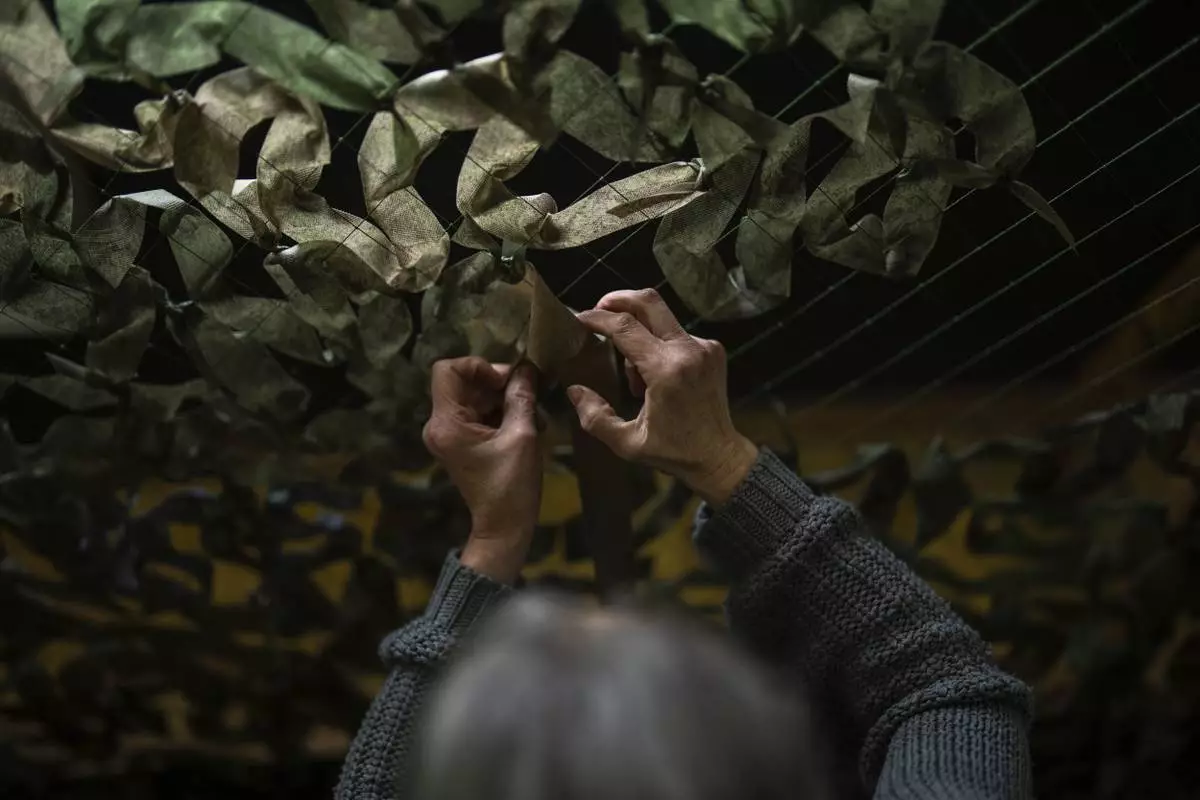
A volunteer makes a camouflage net at a facility producing material for Ukrainian soldiers in Kyiv, Ukraine, Monday, April 22, 2024. A newly approved package of $61 billion in U.S. aid may prevent Ukraine from losing its war against Russia. But winning it will be a long slog. (AP Photo/Francisco Seco)
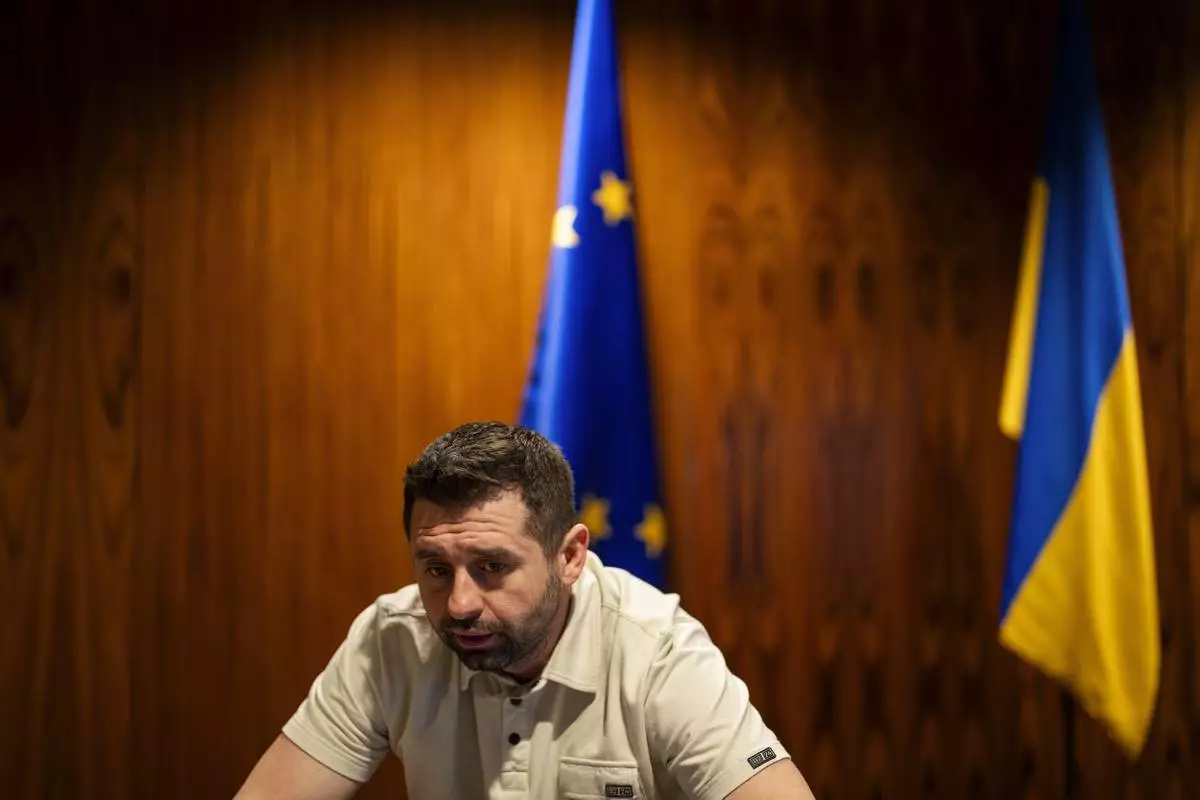
Davyd Arakhamia, a lawmaker with Ukrainian President Volodymyr Zelenskyy's Servant of the People party, talks during an interview with Associated Press in Kyiv, Ukraine, Monday, April 22, 2024. (AP Photo/Francisco Seco)

A woman rallies to raise awareness on the fate of Ukrainian prisoners of war in Kyiv, Ukraine, Sunday, April 21, 2024. (AP Photo/Francisco Seco)

Ribbons with the colors of the European Union and Ukraine are attached to a tree next to memorial wall of Ukrainian soldiers killed during the war in Kyiv, Ukraine, Monday, April 22, 2024. (AP Photo/Francisco Seco)
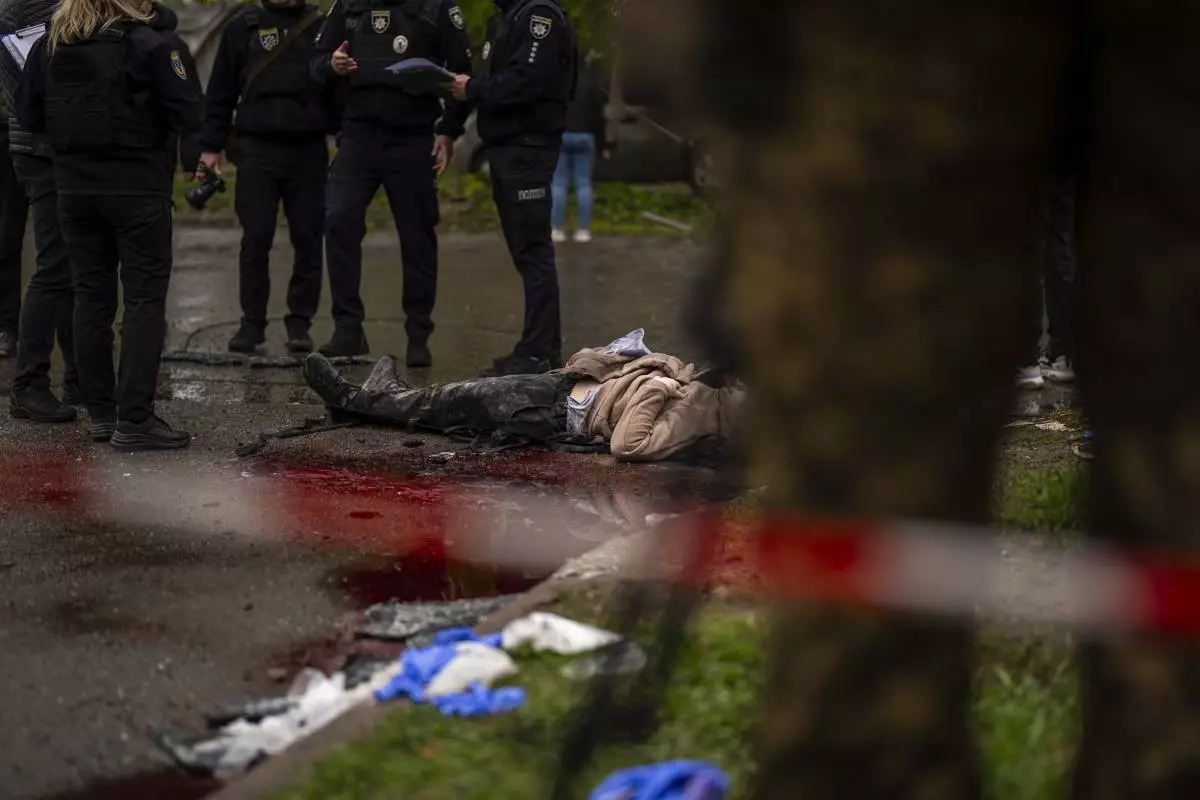
The body of a woman killed by Russian bombardment in Chernihiv, Ukraine, Wednesday, April 17, 2024. (AP Photo/Francisco Seco)

Soldiers carry the coffins of two Ukrainian army sergeants during their funeral in Lviv, Ukraine, Tuesday, April 16, 2024. (AP Photo/Francisco Seco)

















